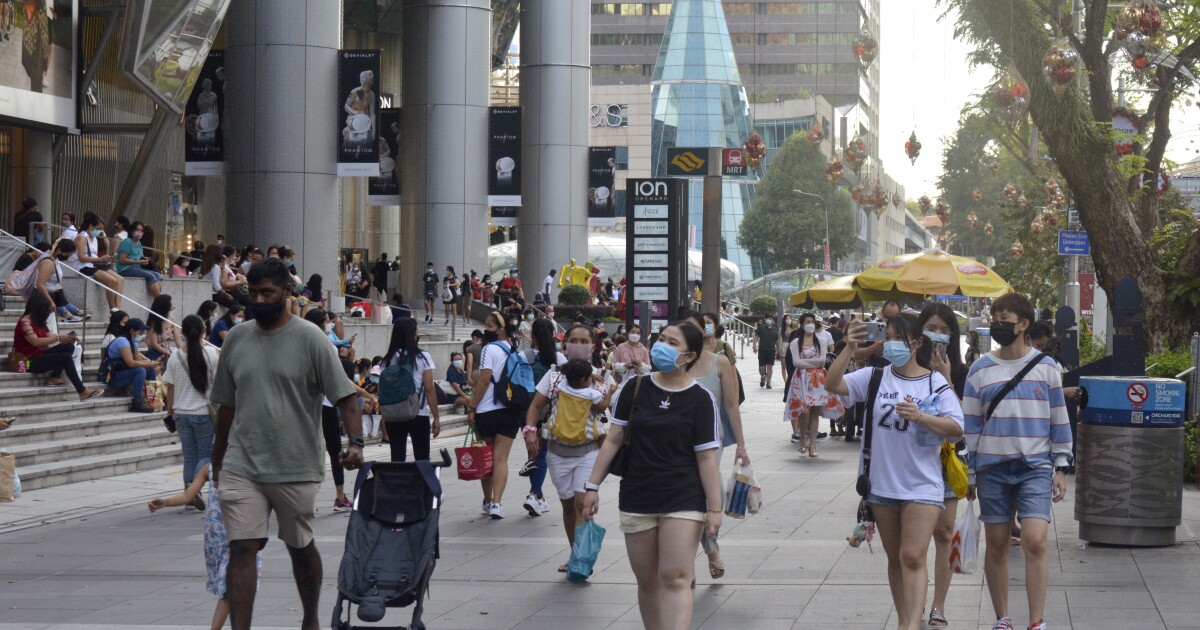When Singapore decided to live with COVID-19, relying on one of the best vaccination programs in the world, infections soared and many wondered if they had not made a mistake.
But the numbers of infections fell as quickly as they rose and now confidence is growing that this small city-state has the virus under control, despite the appearance of the worrisome omicron variant, and can help determine what works and what no.
“I would say COVID now looks like a normal cold,” Glacier Chong said while shopping on popular Orchard Road. “Everyone is getting used to it. It gives the impression that having COVID is normal, that it is a curable disease ”.
That confidence stems in part from the latest statistics.
94% of the population eligible to receive the vaccine is immunized and 26% have already received even the third booster dose. Although the number of infected is increasing again, 99% of those infected have no or very mild symptoms. The attention centers were overloaded, but not overwhelmed. And while deaths increased, they remain low, especially older people with other health problems. The vast majority of the deceased, on the other hand, had not been vaccinated.
Singapore managed to vaccinate so many people by ensuring that nothing was preventing them from getting the vaccine, increasing difficulties for those who did not get vaccinated – with things like banning going to restaurants and shopping centers – and building confidence in the government’s handling of the pandemic, according to Alex Cook, an infectious disease specialist at the National University of Singapore’s Saw Swee Hock School of Public Health.
“Perhaps the best lesson from the Singapore experience is that you have to make vaccines easier to access and make life difficult for those who don’t get immunized,” Cook said.
At the beginning of the pandemic, this important global commercial center kept the infection rate low for almost a year by appealing to a strict quarantine.
A strong vaccination campaign, an aggressive COVID-19 testing program and a good infection tracking system, combined with strong guidelines for the population, made this nation of 5.5 million people feel safe enough to face a new phase in August.
COVID-19 began to be treated as an endemic disease, impossible to totally eradicate, and people were allowed to resume their normal lives.
In addition to having most of the population vaccinated, Singapore felt that its testing program was comprehensive enough to be able to identify and isolate any potential outbreaks, and that its health system was in a position to deal with the most severe cases.
The highly contagious new delta variant complicated matters and in September the government tightened some measures. It reduced, for example, the number of people who could meet at restaurants and other social events.
By the end of October, Singapore recorded nearly 700 cases per million people over seven days, its worst rate since the start of the pandemic.
This week there are 258 infections per million people. It is a high number, but with a clear declining trend. It registered more than 5,300 infections a day and now there are less than 1,000.
The highest average death toll for seven days was 2.57 per 1 million people, reached on Nov. 10. There is now one death per million, according to Our World in Data.
For comparison, neighboring Malaysia had 12.71 deaths per million people in September. Malays are also experiencing a sharp reduction in the number of deaths and are now on par with Singapore, helped by vaccines. Almost 80% of the population has been inoculated.
Cook believes it was perhaps a mistake to allow people with mild or asymptomatic symptoms to stay home without going to hospitals from August. The intention was to ease the burden on medical centers, but this led to a sharp increase in infections.
“In the future,” he said, “when dangerous viruses emerge, countries should seriously reconsider the advisability of allowing patients to recover at home, no matter how mild their symptoms are.”
The restrictions were relaxed again, but Prime Minister Lee Hsien Loong said on Sunday that the appearance of the omicron variant could change things and that the population must prepare for “new setbacks.”
Health Minister Ong Ye Kung said Tuesday that he would suspend the lifting of some restrictions for now and increase testing of foreign visitors and front-line personnel, waiting to see how the new variant evolves.
Still, the bridge connecting Singapore and the Malay Peninsula, which had been closed for nearly two years, was reopened on Monday.
_____
Rising reported from Bangkok.
–


